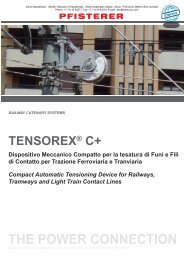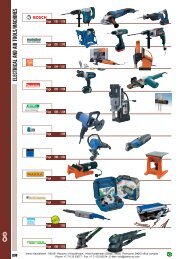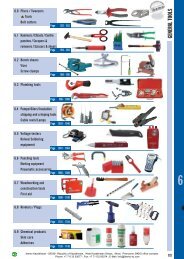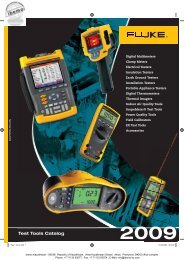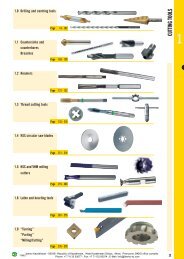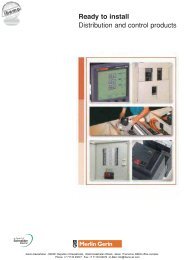General Catalogue 2007 - Ibemo Kazakhstan Ltd
General Catalogue 2007 - Ibemo Kazakhstan Ltd
General Catalogue 2007 - Ibemo Kazakhstan Ltd
You also want an ePaper? Increase the reach of your titles
YUMPU automatically turns print PDFs into web optimized ePapers that Google loves.
Residual current devices<br />
A residual current device (RCCB) is the generic term for a device<br />
which simultaneously performs the functions of detection of the<br />
residual current, comparison of this value with the rated residual<br />
operating value and opening the protected circuit when the residual<br />
current exceeds this value.<br />
For fixed domestic installations and similar applications we have two<br />
types:<br />
• Residual current operated circuit-breaker without integral<br />
over-current protection (RCCB’s) which should comply with the<br />
requirements of BS EN 61008<br />
• Residual current operated circuit-breaker with integral<br />
over-current protection (RCBO’s) which should comply with the<br />
requirements of BS EN 61009<br />
Both RCCB’s and RCBO’s are further divided into types depending<br />
on their operating function :-<br />
Type AC For which tripping is ensured for residual sinusoidal<br />
alternating currents, whether suddenly applied or slowly rising.<br />
Marked with the symbol.<br />
Type A For which tripping is ensured for residual sinusoidal<br />
alternating currents and residual pulsating direct currents, whether<br />
suddenly applied or slowly rising . Marked with the symbol.<br />
Type S For selectivity, with time-delay. Marked with the symbol.<br />
RCCB’s must be protected against short-circuits by means of<br />
circuit-breakers or fuses. RCBO’s have their own in built short-circuit<br />
protection, up to it’s rated value.<br />
The drawing opposite shows how a torroid is located around the line<br />
and neutral conductors to measure the magnetic fields created by<br />
the current flowing in these conductors. The sum of the magnetic<br />
fields set up by these currents (which takes into consideration both<br />
the magnitude and phase relationship of the currents) is detected by<br />
the torroid.<br />
In a normal healthy circuit the vector sum of the current values<br />
added together will be zero. Current flowing to earth, due to a line<br />
earth fault, will return via the earth conductor, and regardless of load<br />
conditions will register as a fault. This current flow will give rise to a<br />
residual current (Ires) which will be detected by the device.<br />
It is most important that the line and neutral conductors are passed<br />
through the torroid. A common cause of nuisance operation is the<br />
failure to connect the neutral through the device.<br />
RCCBs work just as well on three phase or three phase and neutral<br />
circuits, but when the neutral is distributed it must pass through the<br />
torroid.<br />
RCCBs are not suitable for use on dc systems and unearthed<br />
networks.<br />
RCCBs – domestic installation<br />
RCCBs can be installed in two ways:<br />
1. Whole house protection.<br />
2. Selective protection.<br />
RCCBs<br />
Whole house protection is provided typically by a consumer unit<br />
where the RCCB device serves as the main switch. Although very<br />
popular this suffers from a disadvantage: all circuits are disconnected<br />
in the event of fault. Selective protection can be provided by<br />
associating the RCCB with identified high risk circuits by adopting<br />
one or more of the following:<br />
Principle<br />
Fig 28<br />
Current flowing through torroid in healthy circuit<br />
I res = I 1 -I 2 = 0<br />
Current flowing through torroid in circuit with earth fault I 3<br />
I res = I 1 -I 2 +I 3 = I 3<br />
• Split busbar consumer unit:<br />
All circuits are fed via an overall isolator and selected circuits fed<br />
additionally via the RCCB. Typical circuits fed direct are lighting,<br />
freezer, storage heating: and circuits fed via the RCCB are socket<br />
outlets, garage circuits. This concept minimises inconvenience in<br />
the event of fault.<br />
Individual RCBO<br />
each separate final circuit requiring protection by a RCD can be<br />
supplied through an RCBO. This method provides the best solution<br />
for minimising inconvenience.<br />
Nuisance Tripping<br />
All Hager RCCBs incorporate a filtering device preventing the risk of<br />
nuisance tripping due to transient voltages (lightning, line<br />
disturbances on other equipment...) and transient currents (from high<br />
capacitive circuit).<br />
Pulsating DC Fault Current Sensitive<br />
Increasingly, semi-conductors are also extensively used in<br />
computers, VDUs, printers, plotters... all of which may be fed from<br />
the mains electrical supply. The presence of semi-conductors may<br />
result in the normal sinusoidal ac waveform being modified. For<br />
example, the waveform may be rectified or, as in asymmetric phase<br />
control devices, the waveform may be chopped. The resulting<br />
waveforms are said to have a pulsating dc component.<br />
In the event of an earth fault occurring in equipment containing<br />
semi-conductor devices, there is a probability that the earth fault<br />
current will contain a pulsating dc component.<br />
Standard type AC may not respond to this type of earth fault current<br />
and the intended degree of protection will not be provided.<br />
Hager <strong>Catalogue</strong> <strong>2007</strong> • Technical<br />
3.57<br />
ibemo <strong>Kazakhstan</strong> - 090301 Republic of <strong>Kazakhstan</strong>, West <strong>Kazakhstan</strong> Oblast, Aksai, Pramzone, BKKS office complex<br />
Phone: +7 71133 93077 ; Fax: +7 71133 93074 ; E-Mail: info@ibemo-kz.com<br />
Protection<br />
Devices



